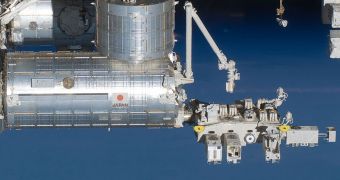A little-known instrument affixed to the outer hull of the International Space Station (ISS) is helping astronomers gain a deeper understanding of the Universe. The Monitor of All-sky X-ray Image (MAXI) experiment sees some of the most energetic light available in the night sky.
Recently, two new research papers on advancing astrophysics were published in respected journals, featuring data collected by MAXI and spacecraft such as the NASA Swift Gamma-Ray Burst Mission. These assets in space help experts understand the life cycle of the Universe in great detail.
The instrument, an X-ray slit camera, is installed aboard the ISS Japanese Experiment Module, which is also known as Kibo. MAXI conducts a full survey of the sky every 96 minutes, scanning for any potential variations in the intensity of distant X-ray sources.
This type of wide-field search led to the identification of the MAXI J1659-152 binary system, consisting of a regular star and a massive, rapidly-rotating black hole. Such systems hold great potential for improving our understanding of large-scale, high-energy physics interactions.
MAXI was developed, and is operated, by the Japan Aerospace Exploration Agency (JAXA), through the downlink center at the Institute of Physical and Chemical Research (RIKEN). This is where all instrument data are published and shared from.
The first of the two recent papers MAXI data contributed to was published in the December 2013 issue of the Astrophysical Journal, and is entitled Extraordinary Luminous Soft X-Ray Transient MAXI J0158-744 as an Ignition of a Nova on a Very Massive O-Ne White Dwarf.
“Some novae may be progenitors of type Ia supernovae, which are used as standard candles to measure the distance scale – thus expansion—of the Universe and used in research that was awarded the 2011 Nobel prize in physics,” says RIKEN expert Mikio Morii, PhD, the lead author of the paper.
“MAXI J0158-744 offers an extreme case of a nova, and it is therefore very useful for understanding the physics in nova explosions,” he adds, quoted by Technology.
The second paper MAXI data contributed to was published in the November 21, 2013 issue of the top journal Science, and was titled “GRB 130427A: A Nearby Ordinary Monster.” The study was centered on analyzing a gamma-ray burst that occurred around 3.8 billion light-years away.
GRB are extremely important for understanding the history of the Universe, since their light is so energetic that it can travel through space almost indefinitely. In some cases, bursts nearly 13 billion light-years away from Earth were discovered, meaning that they were triggered when the Cosmos was less than 1 billion years old.

 14 DAY TRIAL //
14 DAY TRIAL //